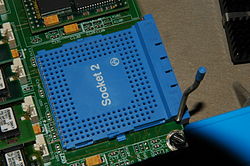 | |
| Type | ZIF |
|---|---|
| Chip form factors | PPGA |
| Contacts | 238 |
| FSB protocol | ? |
| FSB frequency | 25–50 MT/s |
| Voltage range | 5 V |
| Processors | Intel 486 SX, 486 DX, 486 DX2, 486 OverDrive, Pentium OverDrive |
| Predecessor | Socket 1 |
| Successor | Socket 3 |
This article is part of the CPU socket series | |
Socket 2 was one of the series of CPU sockets into which various x86 microprocessors were inserted. It was an updated Socket 1 with added support for Pentium OverDrive processors.
Socket 2 was a 238-pin zero insertion force (ZIF) 19×19 pin grid array (PGA) socket suitable for the 5-volt, 25 to 66 MHz 486 SX, 486 DX, 486 DX2, 486 OverDrive and 63 or 83 MHz Pentium OverDrive processors. [1]